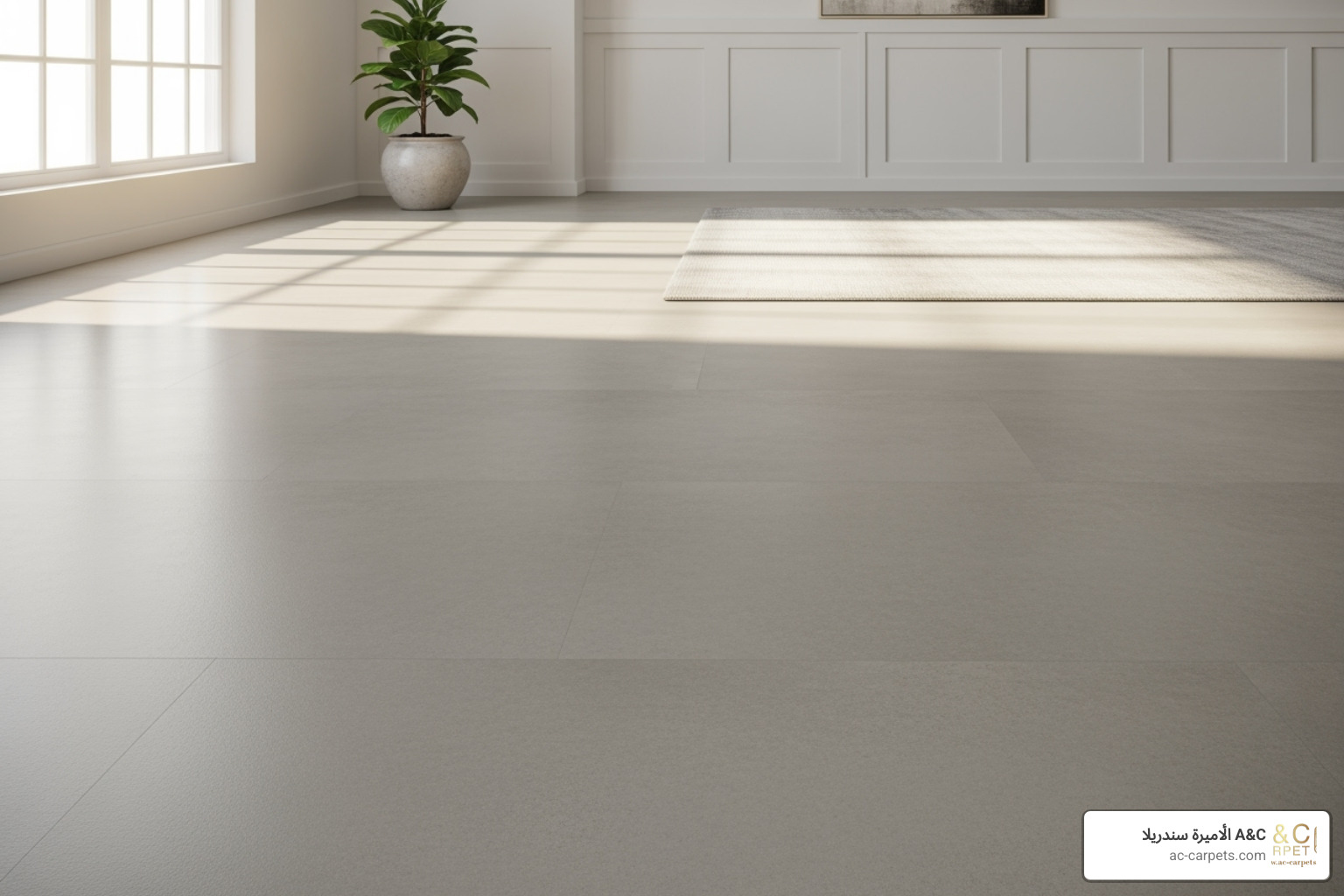Hygienic Vinyl Flooring: 2025’s Smart Choice
Why Clean Floors Matter More Than You Think
Hygienic vinyl flooring is a game-changer for spaces demanding cleanliness and durability. Whether for a busy office, a modern hotel, or a healthy home, your flooring choice directly impacts indoor air quality, infection control, and maintenance costs.
What makes vinyl flooring hygienic:
- Non-porous surface – prevents bacteria, mold, and moisture from penetrating
- Seamless installation – eliminates cracks where germs can hide
- Easy to clean – smooth surface allows for thorough sanitization
- Chemical resistant – withstands harsh cleaning agents without damage
- Water resistant – prevents mold growth and subfloor damage
- Antimicrobial properties – some vinyl floors actively inhibit bacterial growth
Research shows that flooring, one of the largest surfaces in any building, significantly impacts indoor air quality. An industry expert notes, “maintaining cleanliness and safety is vital in environments such as healthcare facilities, laboratories, food and beverage plants, pharmaceutical manufacturing spaces and clean rooms. However, an often overlooked element in these settings is the flooring.”
Modern vinyl flooring solves the hygiene puzzle that traditional materials can’t. Unlike carpet that harbors dust mites or tile with dirt-collecting grout lines, hygienic vinyl flooring creates a barrier against contamination while maintaining aesthetic appeal.
As Ramy Saber, founder of الأميرة سندريلا A&C, I’ve seen how the right flooring transforms spaces into healthier environments. My experience has shown that choosing hygienic vinyl is an investment in both health and long-term cost savings.
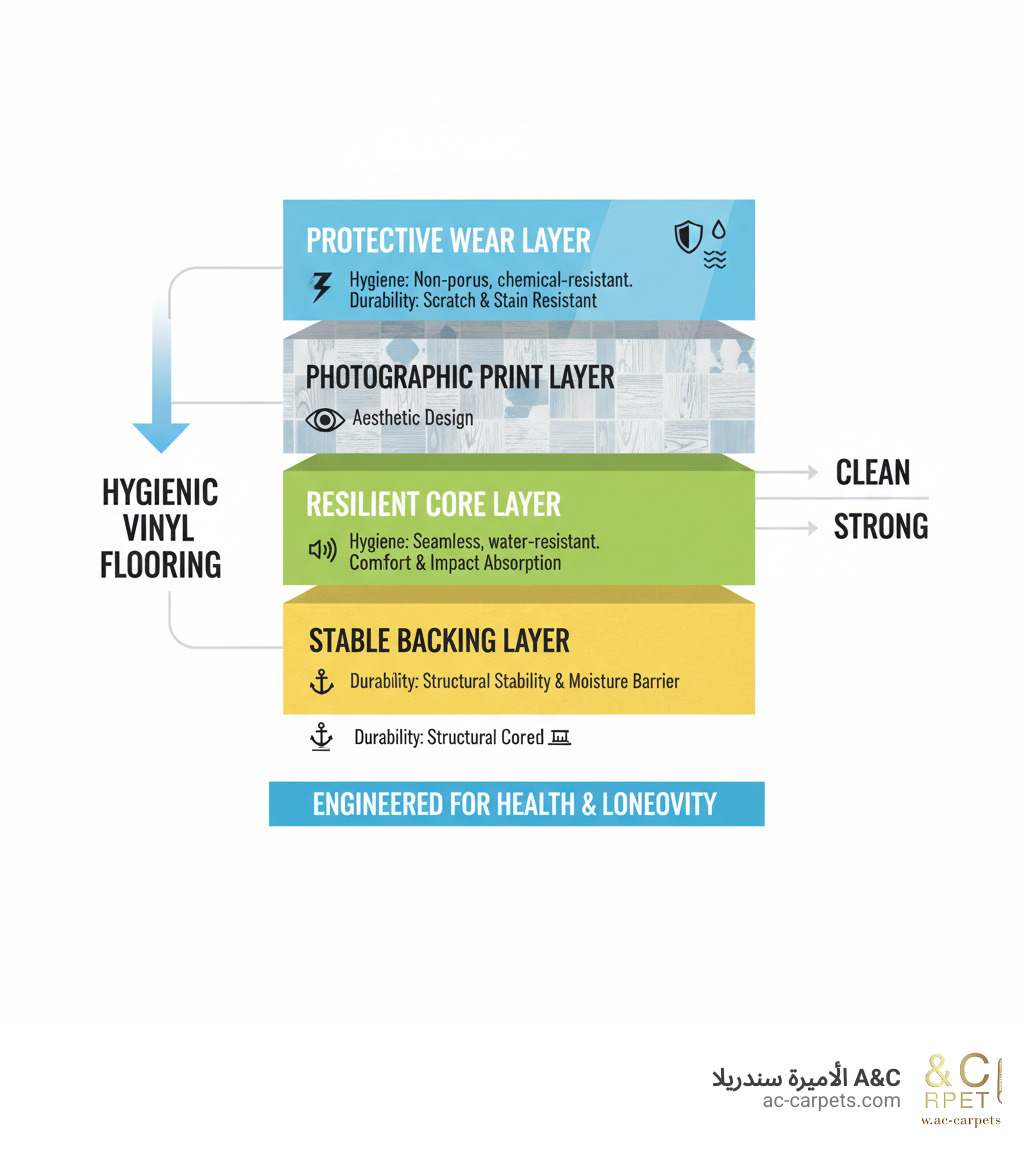
The Science of a Spotless Surface: What Makes Vinyl Flooring Hygienic?
Why do hospitals and laboratories prefer vinyl flooring? The answer lies in the science of what makes hygienic vinyl flooring clean at a microscopic level.
Vinyl’s non-porous surface acts like a shield, preventing bacteria, moisture, and contaminants from penetrating. Unlike materials with tiny pores where germs can hide and multiply, vinyl keeps everything on top for easy removal.
Water resistance is another superpower. Bacteria, mold, and mildew thrive in damp environments. Quality vinyl flooring resists moisture absorption, cutting off the water supply these unwanted guests need. This makes it perfect for kitchens, bathrooms, and any space prone to spills.
Seamless installation is also critical. Traditional flooring often has joints and grout lines that harbor germs. Hygienic vinyl flooring, especially sheet vinyl, can be installed without these vulnerable spots. The National Institutes of Health even published guidelines on the importance of seamless flooring in labs to prevent contamination.
The magic happens through heat welding, a technique where vinyl sheet edges are fused together with heat. This process creates a continuous, impervious barrier with no gaps for contaminants.
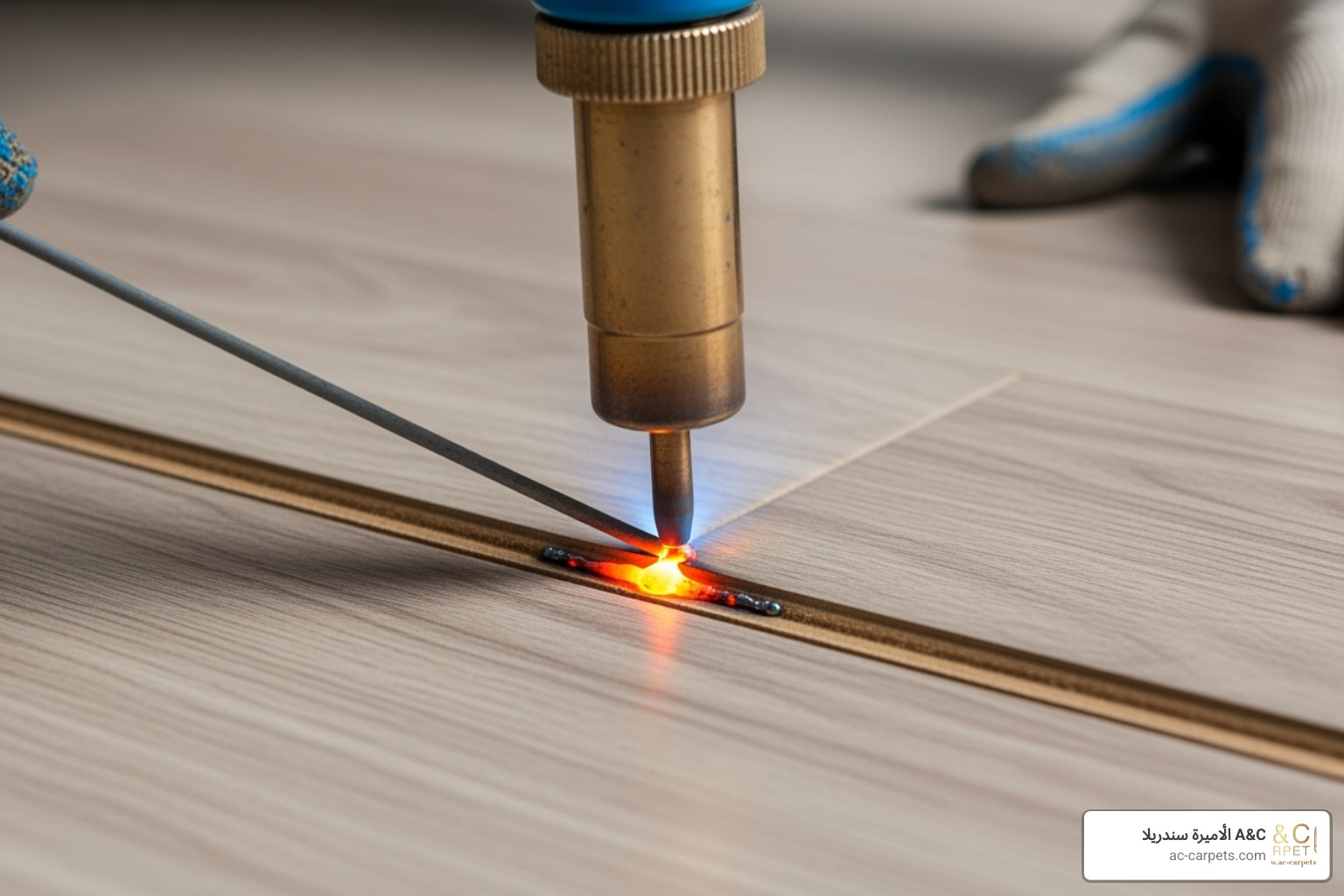
Coved skirting takes hygiene further by extending the vinyl up the wall, eliminating the hard-to-clean corner where dust gathers. It gives germs nowhere to hide and simplifies cleaning.
Modern hygienic vinyl flooring often includes built-in antimicrobial properties. These treatments actively fight bacteria and fungi growth, providing an extra layer of 24/7 protection.
Key Characteristics of Hygienic Vinyl Flooring
Truly hygienic flooring is separated from regular flooring by several game-changing features.
Easy cleaning is paramount. The smooth, non-porous surface means dirt and bacteria can’t dig in. A quick sweep and mop restores a spotless finish.
Chemical resistance ensures the floor can handle hospital-grade disinfectants or everyday cleaners without damage, discoloration, or loss of protective properties.
Stain resistance means spills from coffee, juice, or medical fluids wipe away without leaving a trace.
Durability is crucial for demanding environments. Constant foot traffic and frequent cleaning would destroy lesser materials, but engineered vinyl flooring performs for years.
Moisture resistance and impermeability work together to create an impenetrable barrier against liquids, gases, and microscopic troublemakers.
The Role of a Healthy Indoor Microbiome
Your indoor space has its own ecosystem of microorganisms. Floor surfaces can become major collection points for problematic ones.
Hygienic vinyl flooring helps by reducing harmful bacteria and preventing allergen buildup. Unlike carpet, which can harbor dust mites and pet dander, vinyl’s smooth surface doesn’t give allergens a place to settle.
Water resistance is vital for preventing mold and mildew. These fungi release spores that can impact respiratory health, especially for those with allergies or asthma. By preventing moisture absorption, vinyl flooring evicts these unwanted tenants.
Research in the International Journal of Environmental Research and Public Health confirms how floor surfaces affect indoor microbiomes, showing that your flooring choice directly impacts the air you breathe.
Choosing hygienic vinyl flooring is an investment in cleaner air, fewer allergens, and a healthier environment for everyone.
Benefits in Demanding Environments: Healthcare and Education
In environments where cleanliness is critical, hygienic vinyl flooring excels. Hospitals, schools, and laboratories need flooring that meets demanding requirements for health and safety.
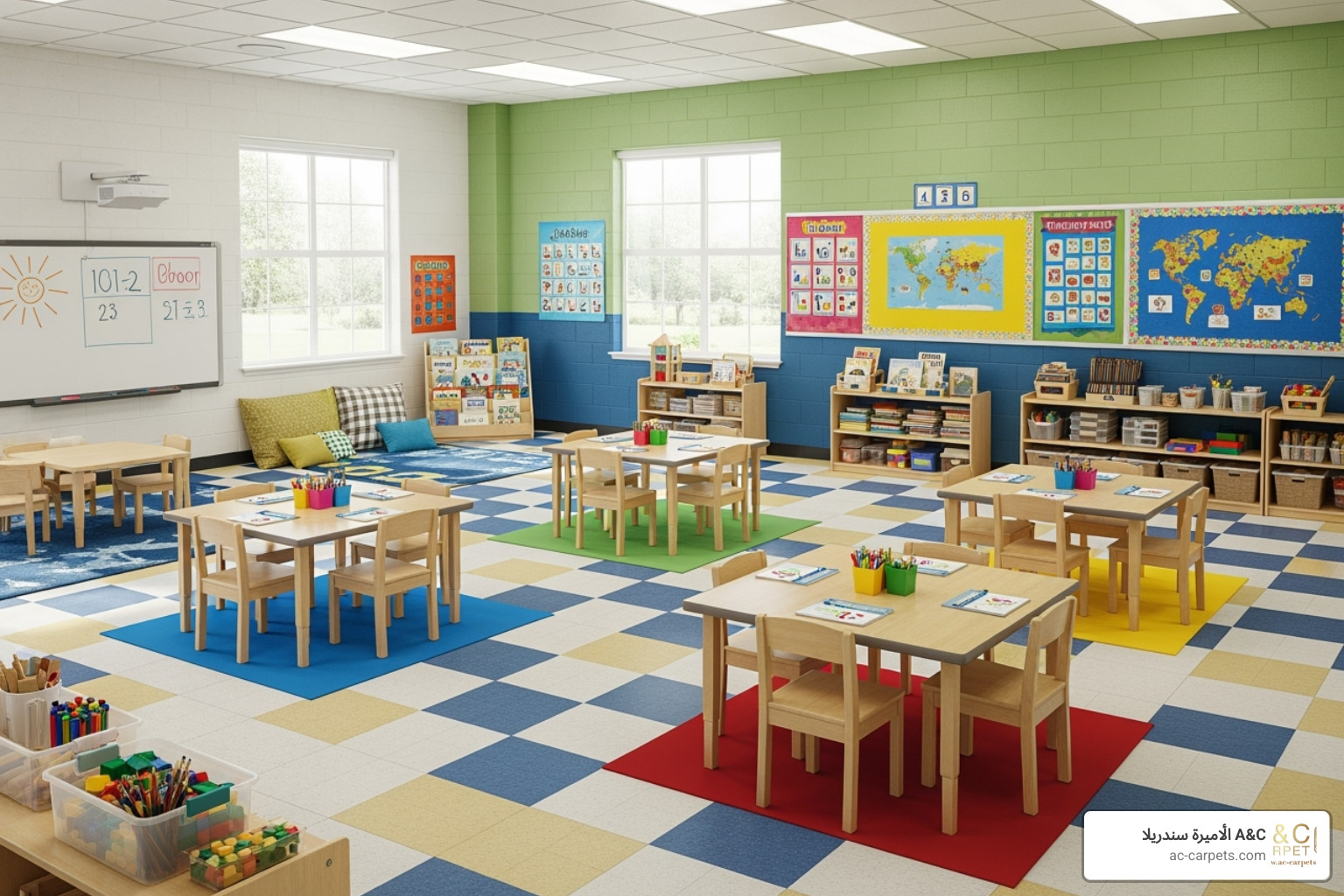
The magic of hygienic vinyl flooring in these settings is its ability to make infection control manageable. The seamless, non-porous surface gives bacteria and viruses nowhere to hide. Its high-traffic durability means it can handle busy hospital corridors or school hallways without showing wear. Modern vinyl can also include slip-resistant properties for safety and be anti-static for use around sensitive electronic equipment.
Financially, reduced maintenance costs allow facilities to allocate resources elsewhere. Easy-to-sanitize flooring lets staff focus on their core mission, whether it’s patient care or education. Most importantly, these floors contribute to improved indoor air quality by not trapping allergens like carpet.
At الأميرة سندريلا A&C, we understand these challenges. Our Hygienic Vinyl Flooring solutions are designed to meet these rigorous demands while maintaining an aesthetic that makes spaces feel welcoming.
Vinyl in Healthcare Facilities
Healthcare environments present extreme flooring challenges. From busy hospitals to specialized clinics, the flooring choice can impact health.
In operating rooms, every surface must be disinfected with harsh chemicals. The seamless nature of vinyl sheet flooring means no grout lines for contaminants. Laboratories benefit from this same principle where contamination control is essential.
The reduced pathogen harborage of hygienic vinyl flooring is vital for compliance with health standards. The right flooring supports infection control protocols. Large medical centers have successfully implemented vinyl solutions, recognizing that durability and hygiene go hand in hand. Emergency departments rely on flooring that can handle intensity while maintaining cleanliness.
Vinyl in Educational Institutions
Educational settings have their own challenges. Schools and universities need flooring that handles everything from paint spills to shuffling chairs. Daycares have specific needs, as young children play directly on the floor.
Allergen reduction for students is particularly important. The smooth, non-porous surface of hygienic vinyl flooring doesn’t trap dust mites, pollen, or other allergens that carpeting might harbor.
Vinyl’s ability to handle heavy foot traffic while maintaining its appearance is crucial in schools. It withstands the daily parade of students and movement of equipment. Acoustic properties also matter; quality vinyl options can help manage sound, creating better learning environments without sacrificing hygiene.
When spills happen, easy cleaning is essential. Hygienic vinyl flooring allows for quick cleanup that prevents stains and bacterial growth, keeping the learning environment healthy.
The Hygienic Advantage: Vinyl Flooring Compared to Other Surfaces
When choosing flooring for clean spaces, compare how hygienic vinyl flooring stacks up against other options like tile, hardwood, or laminate. For true hygiene, not all flooring is equal.
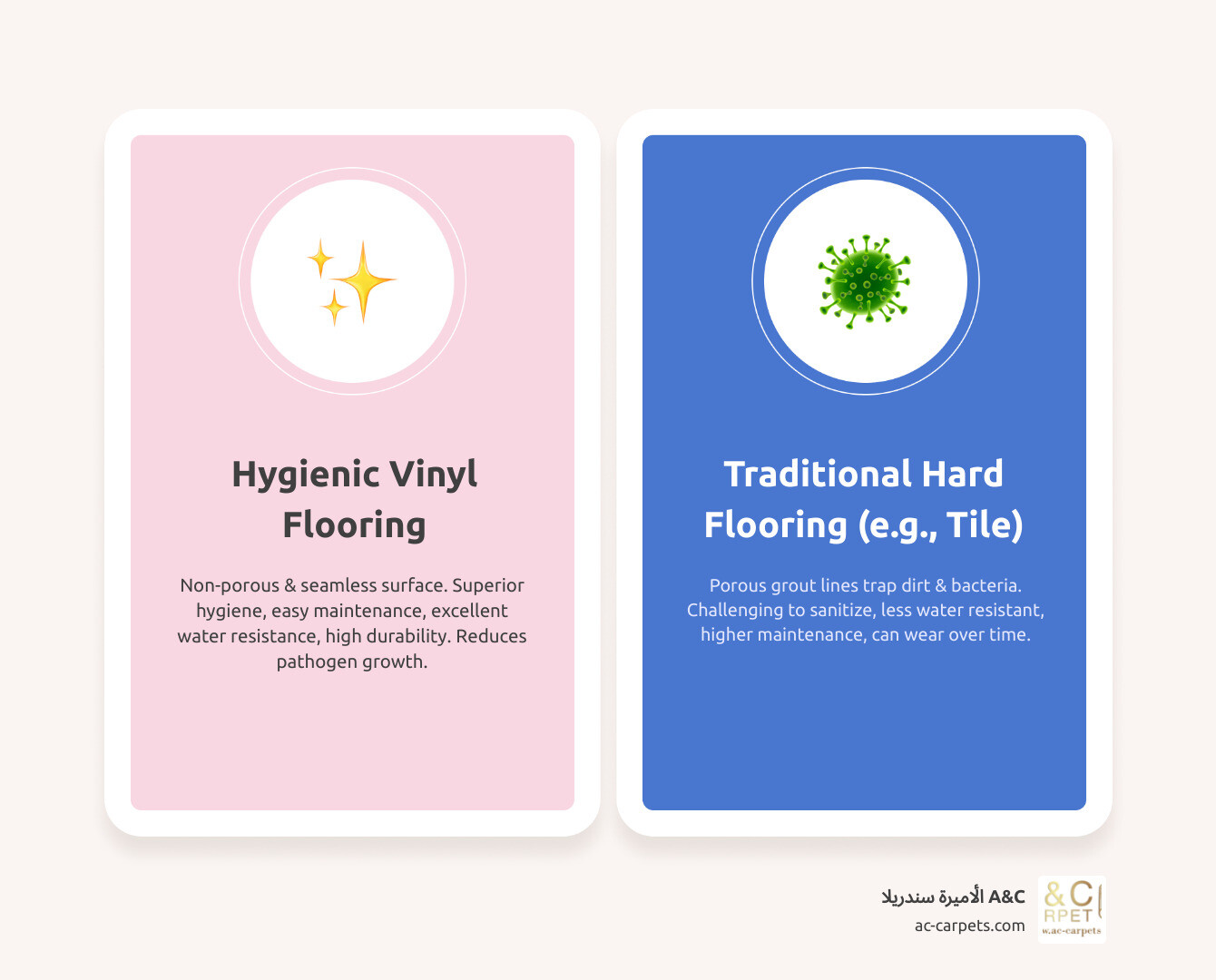
Hygiene isn’t just about a clean look; it’s about what happens in the microscopic nooks where bacteria hide.
Why Vinyl Excels Over Traditional Hard Flooring
Ceramic and porcelain tile are often assumed to be hygienic. While the tile itself is non-porous, the grout lines are hygiene’s enemy. Grout is porous, acting like a sponge for moisture, dirt, and bacteria. Over time, it develops tiny cracks that become breeding grounds for microorganisms, which is why grout looks dingy no matter how much you scrub.
Hardwood flooring offers natural beauty, but it has hygienic limitations. Water can seep into the grain and between boards, creating conditions for bacteria and mold. The seams between planks also hide debris, and harsh disinfectants can damage the wood’s finish.
Laminate flooring has a protective wear layer, but its wood-based core is vulnerable to moisture. If water penetrates the seams, the core can swell and create an environment for mold growth beneath the surface.
Even luxury vinyl planks (LVP) and tiles (LVT) have seams between each piece. While water-resistant and easy to clean, these seams can still collect debris and moisture, creating potential hygiene issues.
This is where hygienic vinyl flooring excels. Sheet vinyl, especially with heat-welded seams, creates one continuous surface. There are no grout lines to harbor bacteria, no wood grain to trap moisture, and no seams for dirt to hide in. It’s a protective barrier covering your entire floor.
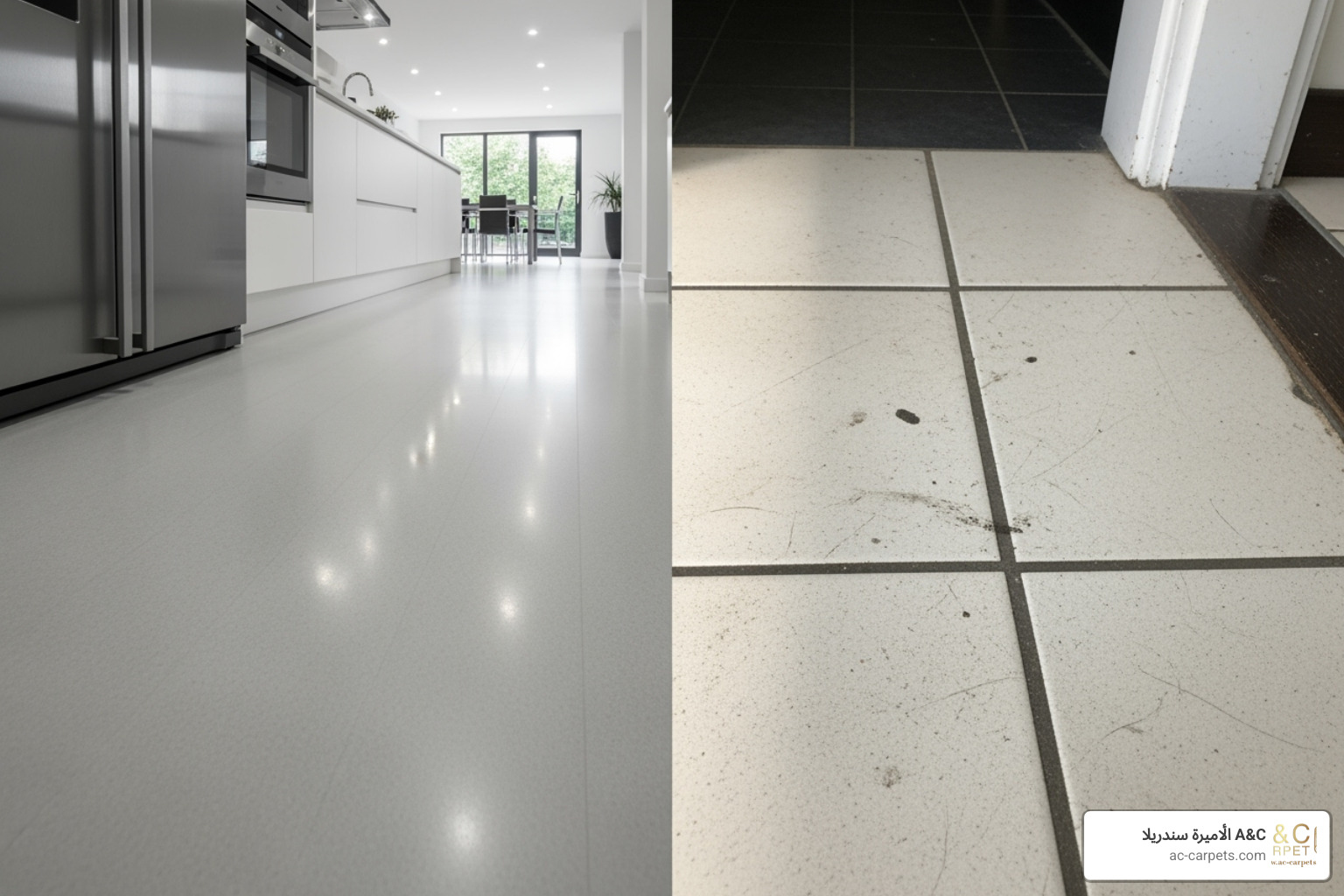
The maintenance difference is clear. With tile, you battle grout stains. With hardwood, you use specialized cleaners and avoid moisture. With hygienic vinyl flooring, you simply sweep, mop with a disinfectant, and you’re done. The seamless, non-porous surface leaves nowhere for germs to hide.
At الأميرة سندريلا A&C, we’ve seen this difference impact our clients. Healthcare facilities report easier maintenance, schools see fewer sick days, and homeowners enjoy peace of mind. When hygiene is the priority, hygienic vinyl flooring exceeds expectations.
A Guide to Choosing and Maintaining Your Vinyl Flooring
Not all vinyl flooring is equally hygienic. At الأميرة سندريلا A&C, we help clients choose the right flooring by focusing on a few key factors.
The biggest decision is between sheet vinyl and Luxury Vinyl Tile (LVT). Sheet vinyl is the gold standard for hygiene, as it can be installed as one continuous surface with heat-welded seams, creating a seamless barrier. LVT, while still excellent for cleanliness, is installed as individual tiles or planks. These seams are tight but can’t match the complete impermeability of seamless sheet vinyl.
Wear layer thickness is another crucial factor. The wear layer is the floor’s protective shield; the thicker it is (measured in “mils”), the better it resists scratches and scuffs that could hide dirt and germs.
Indoor air quality is also important, which is why low-VOC options are key. Modern hygienic vinyl flooring has minimal volatile organic compounds, and many manufacturers offer formaldehyde-free options. Look for certifications like FloorScore or Greenhealth Approval, which indicate the product meets strict indoor air quality standards.
Industry innovations include vinyl floors with built-in antimicrobial treatments that actively fight bacteria. We’re also seeing more PVC-free alternatives for clients who prefer different materials but still want the hygienic benefits of resilient flooring.
Choosing the right flooring can feel overwhelming. Explore our comprehensive guide to flooring choices to understand your options better.
Best Practices for Maintaining Hygienic Vinyl Flooring
Keeping hygienic vinyl flooring clean is surprisingly simple. The same properties that make it hygienic also make it easy to maintain.
Your daily cleaning routine should be straightforward: a quick sweep or vacuum to remove loose dirt before it can scratch the surface.
For wet cleaning, sweeping and mopping with warm water is effective. Use a clean mop and consider a two-bucket system to avoid spreading dirty water.
Neutral pH cleaners are best. Stick with manufacturer-recommended products and avoid harsh or abrasive ones. “Mop and shine” products can leave a film that attracts dirt, and oil-based cleaners can damage the protective wear layer.
Avoiding abrasive tools like steel wool or stiff brushes is crucial. They can create microscopic scratches where bacteria hide. Stick with soft cloths.
The golden rule is immediate spill cleanup. Vinyl’s water-resistant nature means spills sit on the surface, but only if you act quickly. Wipe up spills right away to prevent staining.
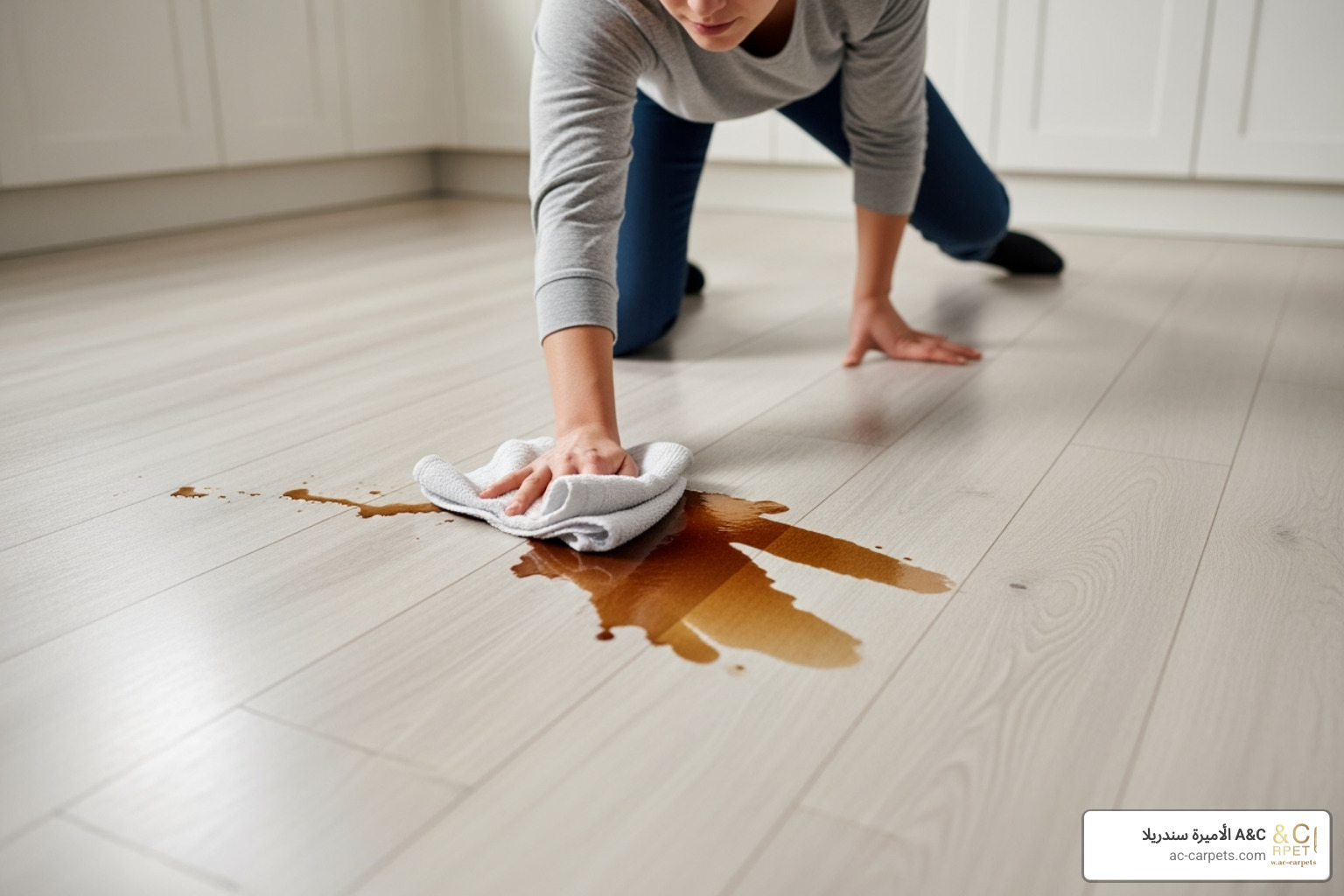
Following these simple practices ensures your hygienic vinyl flooring stays clean, safe, and beautiful. The ease of maintenance is a key reason we recommend vinyl solutions to our clients.
Frequently Asked Questions about Hygienic Vinyl Flooring
Investing in flooring is a big decision. We get many questions about hygienic vinyl flooring from our clients across Egypt, and I’m happy to share what I’ve learned from years in the flooring business.
Is all vinyl flooring hygienic?
The truth is, not all vinyl flooring is created equal. While vinyl is naturally non-porous, there’s a difference between basic vinyl and truly hygienic vinyl flooring.
Key features to look for include a thick, durable wear layer with protective coatings that resist scratches and stains. You’ll also want products that mention antimicrobial treatments, which actively fight bacteria growth.
When comparing sheet vinyl versus planks, sheet vinyl usually wins the hygiene battle because of seams. While vinyl planks (LVP) and tiles (LVT) have hygienic surfaces, every joint is a potential hiding spot for dirt and moisture. Sheet vinyl, when professionally installed, can be nearly seamless.
This highlights the importance of professional installation. Even the best hygienic vinyl flooring can lose its benefits if not installed correctly. Professionals use heat-welded seams to make sheet vinyl truly impervious.
The wear layer quality is also critical. A high-quality wear layer protects the design and maintains the smooth, non-porous surface that keeps contaminants out.
Can hygienic vinyl flooring improve indoor air quality?
Absolutely. Hygienic vinyl flooring can make a real difference in the air you breathe.
The secret is understanding low VOC versus high VOC vinyl. VOCs (Volatile Organic Compounds) are gases some materials release. Older vinyl sometimes had this issue, but modern hygienic vinyl flooring is different.
Off-gassing explained: Today’s quality vinyl products have drastically reduced VOCs, and many are formaldehyde-free. Certifications for air quality like FloorScore or Indoor Air Comfort Gold mean the product meets strict standards for clean indoor air.
Vinyl also improves air quality by preventing mold growth. Its non-porous surface keeps water out, meaning no moisture for mold or mildew to grow. This reduces spores in the air, which is important for people with allergies or respiratory sensitivities.
How are seams in vinyl flooring made hygienic?
This is where skilled craftsmanship makes a difference. The heat welding process creates a permanent bond between vinyl pieces. Installers use specialized tools to melt a vinyl welding rod into the seam, fusing the sheets into one continuous, gap-free surface.
Chemical welding is another option, though heat welding is generally preferred for its superior strength and waterproof seal.
The goal is creating an impervious surface that liquids and contaminants cannot penetrate. This allows for complete disinfection without worrying about what’s underneath.
By preventing bacteria from entering seams, we eliminate the vulnerabilities that plague other flooring types, like tile grout or gaps in hardwood. For more details, you can read about heat welding techniques.
When done right, these seams transform individual sheets into a unified, protective barrier.
Conclusion
It’s clear that hygienic vinyl flooring is more than just another flooring option; it’s a solution for creating clean, healthy spaces.
The science speaks for itself. When you choose hygienic vinyl flooring, you’re investing in a surface that actively works against bacteria, mold, and allergens. Its non-porous, seamless design creates an impenetrable barrier that simplifies cleaning and keeps your space genuinely clean.
Beyond hygiene, the durability of modern vinyl means it stands up to heavy traffic and chemical cleaning in demanding environments like hospitals and schools, all while maintaining its appearance.
And let’s not forget style. Today’s hygienic vinyl flooring comes in stunning designs that complement any space, from a welcoming hotel lobby to a modern home kitchen.
This is a smart investment in health and long-term value. Quality vinyl flooring pays dividends in reduced maintenance costs, improved indoor air quality, and the peace of mind that comes from meeting the highest cleanliness standards.
At الأميرة سندريلا A&C, we understand that healthier spaces start from the ground up. Our factory specializes in innovative carpet alternatives and modern flooring solutions that don’t compromise on elegance or practicality. We offer contemporary designs for homes, offices, and hotels throughout Egypt.
Hygienic vinyl flooring represents the perfect marriage of health, durability, and style. It’s flooring that works as hard as you do, protecting the people who matter most.
Ready to make the smart choice for your space? Explore our neat and practical flooring solutions and find how الأميرة سندريلا A&C can help transform your project into a cleaner, safer, and more beautiful environment.
